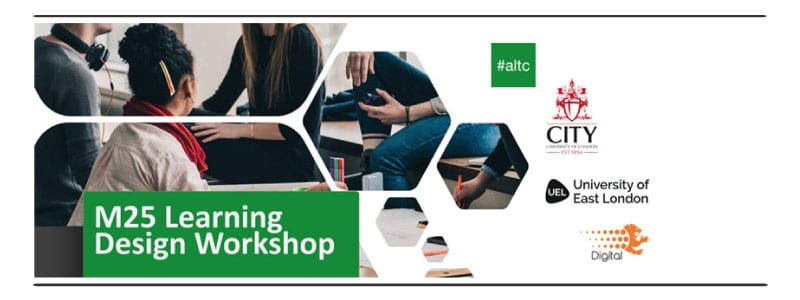On 16th November, the M25 Learning Technology Group (M25 LTG) met at City, University of London for a learning design workshop. The workshop was supported by the Association of Learning Technologists (ALT) and delivered by Dr Maria Toro-Troconis (Head of Academic Research and Quality at CEG Digital).
Twenty learning technologists attended from ten universities within the M25 region. The workshop was planned as a practical follow up to the M25 LTG meeting which took place last July to explore, discuss and share good practice on the theme of Instructional Design and Learning Design. The workshop’s aim was to explore how a learning design framework can be used to support the design of learning. There are several popular learning design frameworks such as UCL’s ABC, Grainne Conole’s 7Cs and Nortthampton’s CAIeRO (which is based on Gilly Salmon’s Carpe diem and Five Stage Model. This workshop was focused on the Course Design Sprint (CoDesignS) Framework.
Contents
Bloom’s taxonomy of learning domains
Maria started the workshop with an overview of how Bloom’s taxonomy of learning domains (psychomotor, cognitive and affective), relate to learning design:
The CoDesignS framework
Maria introduced the CoDesignS Framework which she describes as “a pedagogic method for designing and developing online and blended learning activities through design, and prototyping ideas with academics, course developers and learning designers in an experiential way”. Working in small groups we then took part in a learning activity where we discussed different learning outcomes and had to identify which learning domains they best belonged to. We followed that up with a second activity where we applied the CoDesignS framework to a small learning design.
There are six phases in CoDesignS:
-
Scope: addresses user needs, technology capacity and overall scope of your learning episode.
-
Aims & Objectives: identify what you would like your learners to be able to do.
-
Activity descriptors: addresses the different modes of learning: online / face-to-face / individual work / group work / VLE / external tools
-
Learning descriptors: activities on green cards are associated with the acquisition of knowledge and the development of lower order cognitive skills, activities on blue cards are associated with the development of higher order cognitive skills.
-
Create, Mix and Match: how will you match learning types (enquiry, acquisition, discussion, practice and production) with learning activities? The learning types are taken from Laurillard’s Conversational Framework (2012).
-
Analysis of the Learning: review the different activities you selected for the delivery of your learning episode
CoDesign S for medical education
When the CoDesignS Framework was developed in 2016 it focused on the design of learning and teaching activities in a medical context by clinical and educational supervisors. If you work in a medical context there is a version of the framework which you may find helpful as all activities in this version are mapped to the Academy of Medical Educators’ Professional Standards Framework, the General Medical Council guidelines (Tomorrow’s Doctors) as well as the Advance HE Professional Standards Framework (UKPSF).
Try the CoDesignS framework
I enjoyed this workshop as I think that as learning technologists we need to use sound pedagogical frameworks and models to inform our work and to help us ensure that our primary focus is always on the learning outcomes rather than the technology. If you are interested in finding out more and trying out the CoDesignS framework you can view Maria’s presentation and download the CoDesigns cards on the CoDesignS website.


